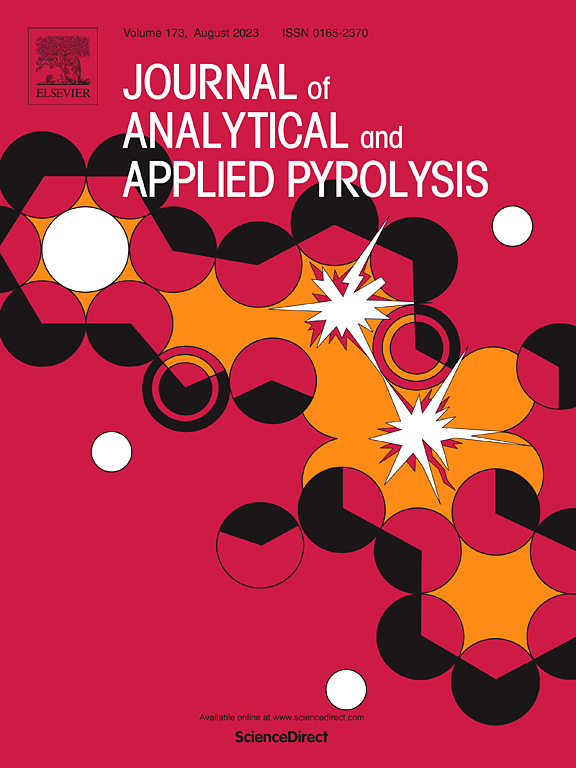结合红外光谱(FTIR-ATR)和分析热解评估浸水新石器时代木材的化学降解途径
IF 6.2
2区 化学
Q1 CHEMISTRY, ANALYTICAL
引用次数: 0
摘要
本研究的重点是通过对O Areal考古遗址(西班牙西北部维戈)考古发掘期间从酸性沼泽沉积物中回收的浸水木材进行化学分析(结合中红外光谱和分析热解),从而进一步了解木材的降解过程。这些树木由八棵橡树(Quercus sp.)和两棵樱桃(Prunus sp.)的残骸组成,放射性碳测定的年代在公元前6100年到5990年 cal BC之间。结果表明,木材的化学成分发生了明显的变化,与多糖和木质素化合物的降解有关。化学变化归因于各种降解过程,包括:(1)多糖的水解,(2)木质素和多糖的部分解聚,(3)木质素的部分氧化。此外,将热解数据与中红外结果进行对比,可以将特定的中红外信号与所研究的浸水木材材料中木质纤维素成分的解聚和氧化联系起来。我们的研究结果指出,对浸水木材化学降解的准确解释需要考虑的因素超出了通常所说的木材多糖含量的消耗。最后,本研究表明,将FTIR-ATR光谱与分析热解相结合,可以全面、详细地分析木材降解过程中的化学变化。这样的结果可能对寻求识别和解决暴露于特定埋藏条件(如高酸性环境)的浸水古木材的脆弱性的保护人员至关重要。本文章由计算机程序翻译,如有差异,请以英文原文为准。
Combining infrared spectroscopy (FTIR-ATR) and analytical pyrolysis for assessing chemical degradation pathways in waterlogged Neolithic wood
This investigation focuses on getting a further understanding of the wood degradation processes based on results obtained by chemical analysis (combining mid-infrared spectroscopy and analytical pyrolysis) of waterlogged woods recovered from an acidic marsh sediment during an archaeological excavation at the O Areal archaeological site (Vigo, NW Spain). The woods consist of eight oak (Quercus sp.) and two cherry (Prunus sp.) remains that were radiocarbon dated between 6100 and 5990 cal BC. The results indicate clear changes in the wood’s chemical composition related to the degradation of the polysaccharide and lignin compounds. The chemical changes are attributed to various degradation processes, including, (i) hydrolysis of polysaccharides, (ii) partial depolymerization of lignin as well as polysaccharides, and (iii) partial oxidation of the lignin. Furthermore, contrasting the pyrolysis data with mid-infrared results enabled to connect specific mid-infrared signals with depolymerization and oxidation of the lignocellulosic components in the studied waterlogged wood material. Our findings point out that an accurate interpretation of waterlogged wood chemical degradation requires considerations beyond the commonly stated depletion of wood polysaccharide content. Finally, this study demonstrates that integrating FTIR-ATR spectroscopy and analytical pyrolysis provides a comprehensive and detailed analysis of chemical changes during wood degradation. Such an outcome may be crucial for conservators seeking to identify and address the vulnerabilities of waterlogged ancient wood exposed to specific burial conditions like highly acidic environments.
求助全文
通过发布文献求助,成功后即可免费获取论文全文。
去求助
来源期刊
CiteScore
9.10
自引率
11.70%
发文量
340
审稿时长
44 days
期刊介绍:
The Journal of Analytical and Applied Pyrolysis (JAAP) is devoted to the publication of papers dealing with innovative applications of pyrolysis processes, the characterization of products related to pyrolysis reactions, and investigations of reaction mechanism. To be considered by JAAP, a manuscript should present significant progress in these topics. The novelty must be satisfactorily argued in the cover letter. A manuscript with a cover letter to the editor not addressing the novelty is likely to be rejected without review.

 求助内容:
求助内容: 应助结果提醒方式:
应助结果提醒方式:


